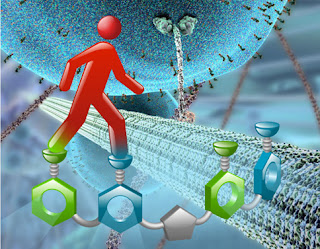Small Molecules in Chemical Space: we don't know the half of it...
 |
| www.catenane.net/home/naturepaper2009december.html |
Growing up in the 1960s, I watched my mother take handfuls of Thorazine, phenobarbital, and God knows what else, every morning after her first cup of coffee. She'd already been through electro-shock treatment and spent time in psychiatric facilities. Later in life they got her on the old psycho-salt diet treating her mental illness with lithium. The funny thing here is that near her death several years ago we talked about how they'd never diagnosed what was wrong with her definitively. Was she schizophrenic? Bi-Polar? Manic? Dissociative? Something else? She said sometimes it seemed like the drugs were what caused her illness after her first breakdown in the early '60s.
The medicines my mom took kept her functional more or less for most of her adult life. She was once a brilliant sociologist with feisty political energy and a penchant for picking fights with people about women's rights and taking care of the poor. By the time she was in her late 60s, though, the drugs she'd been taking pretty much destroyed her ability to interact with others. She spent the last decade of her life shut in a studio apartment in Section 8 housing watching NBC television shows and smoking three packs of cigarettes a day.
I wish there'd been a better way. I wish the pharmacological world of the near future could have been there for her in the early 1960s when the shit hit the fan in her world. She was a great and funny woman. But she had to deal with psychological and emotional imbalances that at times were devastating and other times just stultifying and limiting.
fMRI
We now have the ability to move with purpose on so many fronts of the human mind. Functional magnetic resonance imaging (fMRI) allows neuroscientists and psychologists to map the human mind by tracking blood oxygen flows in the brain. Developments continue in this field allowing scientists to refine imaging in both time and space so that they can understand how the brain reacts to various drugs -- both current and experimental.
In essence, as fMRI technology progresses, it appears that we have for the first time in history diagnostic and research tools that allow scientists to map the mind in all sorts of different states. In theory, as technology continues to develop, this mapping capacity should refine to highly defined levels of both time and space.
As noted in a post earlier this week, research is already being done using fMRI as a tool to understand religious and psychedelic drug effects on the brain.
What's a novemdecillion?
David Jay Brown published an interesting report on advances in psycho-pharmaceutical drugs a few weeks ago that I found very encouraging. His article is called "Psychedelic Medicines of the Future," with the sub-title "more undiscovered drugs than stars in the sky." The link to this piece by Brown can be found at the end of this entry. As always, he provides important insights on the interface between science and mind.
Brown references a paper written by chemists for the American Chemical Society's (ACS) journal Chemical Neuroscience reporting that "scientists have synthesized barely one tenth of 1 percent of the potential drugs that could be made." The emphasis by the authors of the paper is on "small molecule" medicines that can essentially cross cell walls. These small molecules can now be engineered by advanced computer applications. Our ability to manipulate chemical structures is diving deeper and deeper into the microscopic world of chemistry and the combinatorial capacity to literally manufacture new molecules.
According to a press release from the ACS journal, the paper estimates that the actual number of these so-called “small molecules” could be "1 novemdecillion (that’s 1 with 60 zeroes), 1 million billion billion billion billion billion billion, which is more than some estimates of the number of stars in the universe." That's a very big number -- more than some estimates of the number of stars in the universe!
The paper's authors, Jean-Louis Reymond and Mahendra Awale, write in their abstract that “Small molecule drugs exert their action by binding to specific molecular constituents of the cell such as to modulate biochemical processes in a disease modifying manner. The magnitude and specificity of binding depends on the complementarity between the drug molecule and its target in terms of shape, polarity, and chemical functionality.” Small molecules aren't that new. They are, in fact, typical of most medicines. What's new, though, is the vista of opportunity. We like to think that science has a handle on pretty much everything (us non-scientists think this, anyway). However, a novemdecillion is kind of a big number. We have barely begun to scratch the surface.
When you couple the research advances that fMRI technologies offer with these future "small molecules," it's clear that psychologists and psychiatrists should now be thinking very big in solving the problem of mental illness. Perhaps they would have been able to use computerized imaging to clearly characterize my mother's illness, while a pharmaceutical company could have engineered the correct recipe to truly compensate for that illness.
Take this all one step further. As a culture we have an extreme prejudice against performance enhancing drugs in today's sports world. But over the next 50 years it's very likely chemists are going to invent nano-tech type amplifiers that increase, for example, auditory perception for musicians. Or, perhaps, we'll have special memory retention drugs for learning situations.
As Brown writes in his piece: "Perhaps even drugs that improve extrasensory perception, psychic abilities, or facilitate mystical experiences or spiritual transformations, could all be developed with more specificity and efficacy over time." Do we draw a line with this stuff? Do we put on our "old-school" blinders and say if it's not natural then it's not good? Curing cancer and mental illness are one thing, but what about turning up the notch of human potential? What if we could engineer ESP drugs or boost precognitive perception?
R&D, Baby!
All of these developments point to the need for increased investment in psycho-pharmaceutical research and development. New technologies and computer applications will certainly come out of the private sector. But public R&D is also going to be essential if we're really going to boost the potential of the human mind. Reymond and Awale point to a novemdecillion new drugs to deal with all human health. What portion of that new chemistry actually involves the domain of the mind is anyone's guess. After a century of emphasis by the medical establishment on keeping people alive, the benefits of more focus on the mind is all too obvious.
Just as scientists and psychologists need to have vision, it is time for the rest of us to have vision as well and to pay attention to the full potential of human beings. The implications are profound. If we shut ourselves off from this, if we limit our full understanding of the power of science to enhance the mind and the nervous system, don't we defeat the purpose of being human?
My biggest challenge growing up was watching my mom struggle. But the challenge wasn't just her struggle with mental illness, it was her inability to envision getting better. It's understandable. In those days medical science was all about telling her she had to cope with her illness, that it was inevitable. But they couldn't even really tell her what her illness was.
Things are changing now. We've cracked DNA codes, we understand the Genome. We're learning how to chart the mind, and we can synthesize drugs and chemicals like never before. It's no longer about coping, it seems to me. It's about using our creativity, and thinking into the future -- envisioning and evolving out of our limits. If only they had a drug for that kind of thinking! I don't think I need it, but without doubt there's some folks in Washington who do.
*
My thanks to David Jay Brown for inspring this commentary piece. His Catch the Buzz article, "Psychedelic Medicines of the Future," may be found HERE. Follow the links in his article for original source material from the Chemical Neuroscience paper.


Comments
Post a Comment